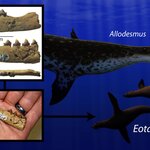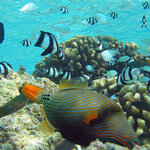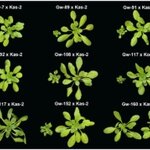Evolution

A fossil discovery has provided a missing link that helps to resolve a more than 5-million-year gap in fur seal and sea lion evolutionary history.
This new genus and species of fur seal has been called Eotaria crypta. Eotaria means 'dawn sea lion'. The species was tiny, with adults being only slightly larger than a sea otter and around the size of a juvenile New Zealand fur seal, according to University of Otago graduate student Robert Boessenecker, who found the fossil while looking through the John D. Cooper Archaeological and Paleontological Center.
Its fossilized partial…

In modern culture, people are taught not to settle. Settling is, of course, subjective and people change so when psychologists are in charge, there are a lot of divorces.
What about when science was in charge? Is it better to settle or hold out for the best mate?
A new evolutionary biology study says that it's better to settle for Mr. Okay than hold out for Mr. Right. And that may be why it is in our nature - traced back to the earliest humans - to take the safe bet when stakes are high, such as whether or not we will mate.
Mr. Right or Mr. Right Now? Let science be your…

Fish vision just got more complex. Janderk, CC BY-SA
By William Feeney, University of Cambridge
Evolution allows animals to develop superb adaptations to survive and flourish in environmental niches. The evolution of fish eyes is one such intriguing example. However, tracing how different kinds of fish eyes evolved is not always easy. New research is finally throwing some light on this evolutionary feat and it is helping us understand how new species are born.
The diversity of life on Earth is a result of evolutionary processes acting over millions of years. Small changes to the genetic make-…

A recently published study offers new clues about the evolution of the immune system in European populations of the plant Arabidopsis thaliana and the underlying genetic mechanisms associated with immunity. The species Arabidopsis thaliana, which is naturally distributed across the northern hemisphere, belongs to the same family than mustard. The species is used as model in plant biology studies because its genome is relatively small and appropriate for genetic studies.
The natural evolution of resistance (R) genes in plants can cause autoimmunity when combined with different genetic…

A study using geckos has found that evolution can downgrade or entirely remove adaptations that have been previously acquired, giving the species new survival advantages.
What would be an advantage to a snake not recovering from limb loss or a gecko losing its ability to adhere to surfaces? Evolutionary fitness is not the same as something we might regard as a useful trait. Some morphological features are considered innovations when they allow an animal to occupy a new niche.
In the gecko study, the researchers found that species of geckos in which the adhesive system was either…

In many species of plants and animals, individuals from the same population often come in different color variants. It's always been that way but why one color doesn't eventually replace the others through natural selection is something of an evolutionary biology mystery.
Namely, how and why do variants of the same animal exist in nature? In theory, different color morphs (variants) should be equally subjected to natural selection.
Will Sowersby, a PhD student at Monash University is lead author of a paper in the Journal of Evolutionary Biology which looked at a species of Central…

Northern Europeans pride themselves on being tougher than the rest of Europe when it comes to enduring weather. While most people are more likely to die in bad weather, a new paper finds that Norwegian kids were more likely to die when the weather was good.
By studying church records from 1750 to 1900 and looking at life history variables, such as how old women were when they had their first child and their last and how many years passed between the birth of each child and how many of these children survived, Gine Roll Skjaervoe at the Norwegian University of Science and Technology's (…
Ribosomes: squiggly and yummy. crobin, CC BY
By Robert Root-Bernstein, Michigan State University and Meredith Root-Bernstein, Aarhus University
Since the discovery that DNA encodes genetic information, research on the evolution of life has focused on its genetic origins.
Following this “genes-first” approach, Oxford University evolutionary biologist Richard Dawkins has argued in his book The Selfish Gene that cells and organisms evolved simply as packages to ever-more efficiently protect and transmit genes.
But this genes-first point of view ignores much. All cells share three organelles, or…

Since the discovery of how DNA encodes genetic information, evolutionary biology has focused on genes. One popular hypothesis - the "selfish gene" theory - states that cells and organisms exist simply as packages to protect and transmit genes.
The selfish gene is by no means accepted and a new paper gives biological 'selfishness' itself a twist, and proposes that if anything is "selfish" it must be the ribosome. That might change everything the public thinks they know about the evolution of life and, in fact, the function of ribosomes themselves.
What came first in the evolution of life? The…

Modern human skeletons, with our lightly-built form, evolved only relatively recently, after the start of the Holocene about 12,000 years ago and even more recently in some human populations, according to a study that used high-resolution imaging of bone joints from modern humans and chimpanzees as well as from fossils of extinct human species.
For millions of years, extinct human predecessors had high bone density. A higher decrease in the density of lower limbs than in that of the upper limbs suggests that the transformation may be linked to humans' shift from a foraging lifestyle to a…